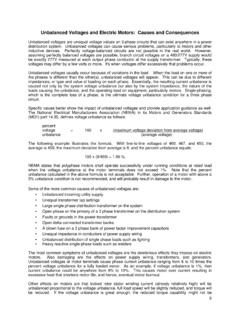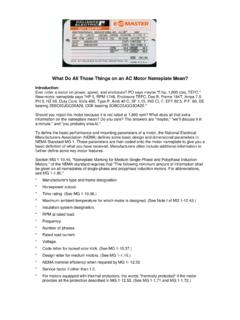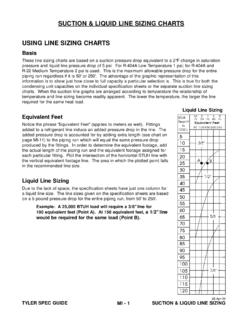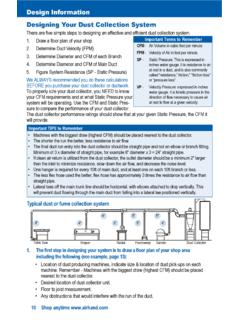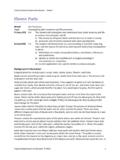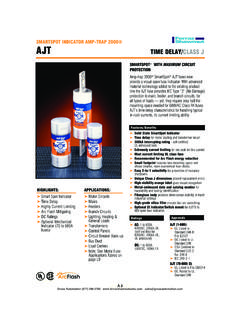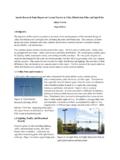Transcription of Unbalanced Voltages and Electric Motors: Causes …
1 8 Unbalanced Voltages and Electric Motors: Causes and Consequences Unbalanced Voltages are unequal voltage values on 3-phase circuits that can exist anywhere in a power distribution system. Unbalanced Voltages can cause serious problems, particularly to motors and other inductive devices. Perfectly voltage -balanced circuits are not possible in the real world. However, assuming perfectly balanced Voltages are possible, branch circuit Voltages on a 480/277V supply would be exactly 277V measured at each output phase conductor at the supply transformer. Typically, these Voltages may differ by a few volts or more. It's when Voltages differ excessively that problems occur.
2 Unbalanced Voltages usually occur because of variations in the load. When the load on one or more of the phases is different than the other(s), Unbalanced Voltages will appear. This can be due to different impedances, or type and value of loading on each phase. Essentially, the resulting current unbalance is caused not only by the system voltage unbalance but also by the system impedance, the nature of the loads causing the unbalance, and the operating load on equipment, particularly motors. Single-phasing, which is the complete loss of a phase, is the ultimate voltage unbalance condition for a three phase circuit. Specific values better show the impact of Unbalanced Voltages and provide application guidance as well.
3 The National Electrical Manufacturers Association (NEMA) in its Motors and Generators Standards (MG1) part , defines voltage unbalance as follows: percent voltage = 100 x (maximum voltage deviation from average voltage ) unbalance (average voltage ) The following example illustrates the formula. With line-to-line Voltages of 460, 467, and 450, the average is 459, the maximum deviation from average is 9, and the percent unbalance equals: 100 x (9/459) = %. NEMA states that polyphase motors shall operate successfully under running conditions at rated load when the voltage unbalance at the motor terminals does not exceed 1%.
4 Note that the percent unbalance calculated in the above formula is not acceptable. Further, operation of a motor with above a 5% unbalance condition is not recommended, and will probably result in damage to the motor . Some of the more common Causes of Unbalanced Voltages are: Unbalanced incoming utility supply Unequal transformer tap settings Large single phase distribution transformer on the system Open phase on the primary of a 3 phase transformer on the distribution system Faults or grounds in the power transformer Open delta connected transformer banks A blown fuse on a 3 phase bank of power factor improvement capacitors Unequal impedance in conductors of power supply wiring Unbalanced distribution of single phase loads such as lighting Heavy reactive single phase loads such as welders The most common symptoms of Unbalanced Voltages are the deleterious effects they impose on Electric motors.
5 Also damaging are the effects on power supply wiring, transformers, and generators. Unbalanced Voltages at motor terminals cause phase current unbalance ranging from 6 to 10 times the percent voltage unbalance for a fully loaded motor . As an example, if voltage unbalance is 1%, then current unbalance could be anywhere from 6% to 10%. This Causes motor over current resulting in excessive heat that shortens motor life, and hence, eventual motor burnout. Other effects on motors are that locked rotor stator winding current (already relatively high) will be Unbalanced proportional to the voltage unbalance, full load speed will be slightly reduced, and torque will be reduced.
6 If the voltage unbalance is great enough, the reduced torque capability might not be 8 adequate for the application and the motor will not attain rated speed. The following table illustrates voltage unbalance effects on a typical Electric motor rated 5 hp, 3 phase, 230V, 60 Hz, 1725 rpm, and service factor. CharacteristicPerformance Average voltage230230230 Percent Unbalanced Percent Unbalanced Increased temperature rise C03040 A most damaging effect is that winding insulation life is approximately halved for every 10 C increase in winding temperature. The unbalance shown in the third column would result in an expected life of only 1/16 of normal due to the additional 40 C rise, a substantial and unacceptable reduction.
7 A motor with a service factor of could typically withstand an unbalance of about provided it is not operated above its nameplate rated horsepower. In this case the unbalance is excessive even for a service factor motor . The following chart illustrates the typical percentage increases in motor losses and heating for various levels of voltage unbalance. A motor often continues to operate with Unbalanced Voltages ; however, its efficiency is reduced. This reduction of efficiency is caused by both increased current (I) and increased resistance (R) due to heating. The increase in resistance and current "stack up" to contribute to an exponential increase in motor heating.
8 Essentially, this means that as the resulting losses increase, the heating intensifies rapidly. This may lead to a condition of uncontrollable heat rise, called "thermal runaway", which results in a rapid deterioration of the winding insulation concluding with failure of the winding. Single-phase operation of a motor deserves special attention because so often electrical maintenance people believe they have provided such protection only to find that their protection did not work. Single-phase operation of a 3-phase motor will cause overheating due to excessive current and decreased output capability. If the motor is at or near full load when single-phasing occurs, it will not develop rated torque and therefore it may stall, that is, come to a stop.
9 The stall condition generates tremendous amounts of current and heat resulting in an extremely rapid temperature rise. If motor protection is not adequate, the stator winding can fail, and the squirrel cage rotor may be damaged or destroyed. The standard three overload starter should not be relied on to provide protection against single phasing. One reason for this is that local internal winding overheating can still occur even when line currents do not Increase in motor Heating and Losses vs. voltage Unbalance0501001500246810 voltage Unbalance %Increase % motor HeatingMotor Losses8 exceed the setting of any one overload. Effective protection against single-phasing requires special sensing devices.
10 A particularly troublesome and complex scenario is the case of multiple motors of different ratings on a circuit that has been single-phased. Frequently, one of the motors generates the missing third phase by acting as a rotary converter. In fact, this form of generation is the principle that is used to make a commercial rotary single to three phase converter. The key difference is that the commercial converter uses capacitors to start, and to adjust the balance of the intentionally generated third phase for proper operation. Consider, for example, the case of a large motor operating in a single-phased mode but carrying less than rated load such that its current is low enough that it does not trip its overcurrent protection.
